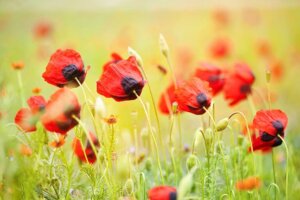Poppy: Learn How to Care for This Wildflower

The poppy is recognized for being one of the most beautiful wildflowers. If you plan to plant it in your garden, make sure you know how to care for it.
It’s an excellent flower for novice gardeners to grow because it doesn’t require a huge amount of effort to help it flourish. If you want to learn how to grow this wildflower in your garden, keep reading!
Types of poppies

The poppy is a wild plant native to Asia and Europe, whose botanical name is Papaver rhoeas. In its adult state, it reaches a little more than 50 centimeters in height. It blooms bright red with a pale interior but is the color scarlet on the reverse.
Although the most common is the Papaver rhoeas, it’s not the only poppy that exists. There are more than one hundred recognized species and these include:
- Eastern papaver: evergreen, with a burgundy flower.
- Ostrich poppy: originates from Europe and its flowers are larger than the traditional ones and it has little foliage.
- Papaver somníferum: this is considered illegal in some countries because narcotics are prepared and extracted from it.
- Papaver rupifragum: stands out because its flowers are orange. It grows in the areas of Cádiz, North Africa, and Malaga.
- Poppy dubium: another species that’s similar to the wild poppy. Its flowering occurs in summer.
The poppy: learn about its care
Poppies are easy to find in a nursery, so you won’t have any problems acquiring them. Although, it’s always an option to buy the seeds and watch them gradually develop.
Either way, depending on your needs, you can grow your flowers in a pot or in the ground. Below, we’re going to explain the general care you’ll need to provide and we’ll also give you some details about the types of places you can plant it.
- Irrigation and substrate: this plant doesn’t require much water, so irrigation should be moderate. In addition, the substrate must be dry, and bear in mind that this plant doesn’t like being transplanted.
- Light and temperature: this wildflower requires good, natural lighting, so don’t grow it in shady areas. When it comes to temperature, it prefers cooler climates with low temperatures. Although it can also thrive in temperate and warm areas.
Potted poppy care
If you’ve decided to buy a potted poppy or plant it in a container, terracotta pots are better. Unlike plastic ones, these promote drainage and prevent stagnation. Remember, these flowers don’t like wet soil!
Planting your poppy in the ground
Without a doubt, the best way to plant your poppy is in the ground. By doing this, you won’t have to worry too much about drainage. If you’re going to sow the flower from seed, use fertilizer and choose a spot in direct sunlight.

The poppy is a medicinal plant
In addition to being a beautiful flower, the poppy is a medicinal species that’s been used throughout the ages.
In particular, it can be used as an infusion to treat insomnia. This is because it contains isoquinoline alkaloids that help reduce stress, and anxiety, calm the nerves, and as a result, improve the quality of rest.
Before consuming it, you should discuss its use with your physician to ensure that it’s right for you. A specialist will also be able to explain and recommend the best way to prepare your infusion and the precise amount you should use.
Enjoy your poppies!
As you now know, the poppy is a beautiful wildflower and it’s very easy to care for. It doesn’t need a lot of your time or attention in order to flourish. Follow these simple but concrete tips and you’ll soon be rewarded with a garden full of color and vitality.
All cited sources were thoroughly reviewed by our team to ensure their quality, reliability, currency, and validity. The bibliography of this article was considered reliable and of academic or scientific accuracy.
- Ana R Ramírez Jiménez, et al. Alternativa con gel de Papaver somniferum y Cannabis sativa, como tratamiento de artritis reumatoide. Enf Neurol (Mex). Vol. 10, No. 1: 16-20, 2011.
- López Luengo, María Tránsito. El insomnio. Plantas medicinales con efecto sedante. Offarm. Vol. 20, 2001.








